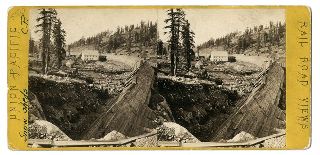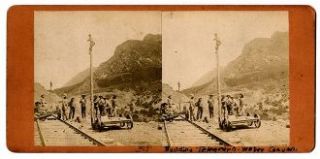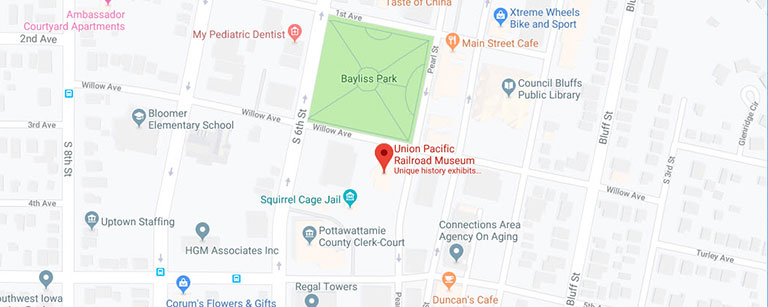Union Pacific's A.J. Russell Collection

Andrew J. Russell, Cut No. 8, east end of Red Buttes, circa 1868
Earning only $3 per day, grading crews under Lewis Carmichael worked tirelessly to prepare the way for Union Pacific's track laying crews. Cuts like this were established one shovel load at a time and had to be unloaded one wagon at a time.
Among the many photographers represented in Union Pacific's vast photography collection, one of the earliest and more prolific was Andrew J. Russell. Born in 1830, Russell was originally trained as a landscape painter, and it was not until after he enlisted with the Union Army in 1862 that he learned the art of wet plate, collodion photography. This cumbersome process required the photographer to prepare glass slides by coating them with a thin layer of nitrocellulose dissolved in ether and alcohol and mixed with potassium iodide. The plates were then dipped in a silver solution which made them light sensitive. Before the plate dried out it was exposed using sunlight through the lens of the camera. Prints were made from these negative plates, most often onto albumen coated paper. These albumen prints are extremely sensitive to UV light. When exposed over time to light the images gradually disappear.

Andrew J. Russell, Snow sheds looking west from Summit, 1869
In late 1866 and early 1867, Central Pacific workers experienced 44 snowstorms - the worst winter in memory in the Sierra Nevada. With so much snow, supply trains could not get through, and more than half of the workers were occupied just clearing the track. Desperate to move forward, Central Pacific built a roof over the track to keep the snow off. In 1868, 2,500 men and six trains were dedicated solely to construction of these snow sheds. By 1873, Central Pacific had built more than 30 miles of massive snow sheds at a cost of $2 million. The innovation was tremendously successful and was eventually adopted by Union Pacific and European railroads.
In 1868, Russell was engaged by Union Pacific to document the construction of their portion of the first transcontinental railroad from Omaha, Nebraska, to Promontory Summit, Utah. He did so using two different cameras, but the same wet plate process. One camera used large glass plates averaging 10X13 inches. The other camera captured two images at the same time; a stereo camera. Cards were printed with these dual images that, when viewed with a stereo viewer, would create one surprisingly clear 3-D image.
A.J. Russell's work is scattered in public and private collections, but Union Pacific's photographic collection is by far the most comprehensive. Union Pacific owns:
About 600 Russell stereo cards, some of which are rare.
Three Great West Illustrated albums, each containing 50 images, produced from the 10x13" glass negatives, the most albums in any collection.
About 85 additional, large-format albumen photographs, some of which do not exist in any other collection, either in negative or print form. Some possess photographic plate labels from Russell's studio and are thought to be the only labeled prints in existence.
A free 3-D brochure using stereo images from the construction period is available for visitors to the Museum. A 3-D book of Union Pacific's stereocard collection containing more than 50 images is also available for purchase in the gift shop.

Andrew J. Russell, Telegraph Corps, Weber Canyon,1869
In 1861, Edward Creighton extended the first telegraph line from Omaha to Salt Lake City where it connected with the Western Union Line. The Pacific Railway Act of 1862, which helped to establish Union Pacific, stipulated: "An Act to aid in the Construction of a Railroad and Telegraph Line from the Missouri River to the Pacific Ocean, and to secure to the Government the Use of the same for Postal, Military and Other Purposes." The telegraph line consisted of cedar poles, 35 to the mile, with cross arms and two wires. Much of the original Creighton telegraph line was moved to the railroad's right-of-way during the railroad's construction.

